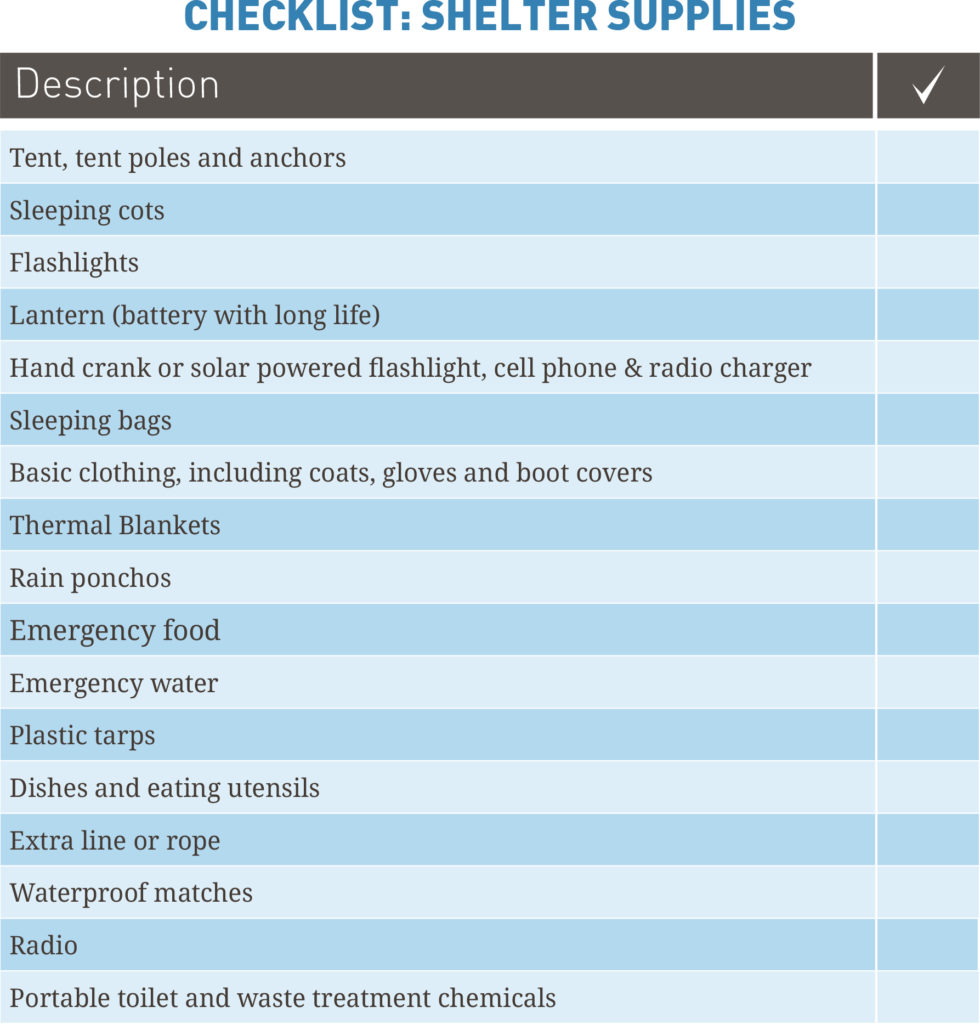SHELTER
There are two ways to think about shelter:
- What to do should a disaster make your home uninhabitable
- Preparing a space where family members are kept safe and secure in the case of events like a terrorist attack, rioting and looting, or a natural disaster
In the 1960s, people began building fallout shelters because they were afraid of nuclear war. It is a bit incredible that over 50 years later, that same fear exists, with modern crises including biological warfare and terrorist attacks added on.
This is in addition to natural disaster threats, like tornadoes and earthquakes that can quickly leave a family homeless. Severely damaged homes present a safety risk and can be declared inhabitable. What then?
This section primarily addresses preparing in advance to ensure your family has options for shelter should a crisis occur.
The survival process occurs on a continuum. When a event occurs, this is a typical pattern:
- Family immediately finds safety, which may mean leaving the home due to damage
- Family finds short-term emergency shelter when the home is inhabitable
- Family finds temporary alternative housing
- Family seeks more permanent living arrangements
Short-term displacement is typical for a natural disaster. However, there are two problems people face after a natural disaster.
- The need for protection from the weather
- The need to protect possessions now subject to looting
Both problems often lead people to set up temporary camp on their own property rather than relocate to a temporary shelter. Preparing in advance to ensure your family has shelter no matter what happens may mean reinforcing the house by building a safe room and assembling temporary shelter supplies.
A safe room can provide protection in a variety of situations that include war, rioting, tornadoes, and hurricanes. It is not useful for disasters like floods and earthquakes. The one major drawback to a safe room is the expense.
Building a safe room makes sense when:
- You live in an area with high risk of extreme winds or a man-made crisis
- You are unable to reach an emergency shelter before severe storms or cannot escape to safety during an attack
- You can afford the cost of a shelter
FEMA measures risk by considering the wind zone the house is located in and the number of tornadoes that have occurred per 1,000 square miles in the area. If you live in a high risk area, a shelter is recommended. As far as man-made threats, adding a shelter to your home may make sense if you live in a big city, a high crime area, or a city where terrorist acts have already occurred or are likely to occur.
As mentioned, even if you build a safe room, there will be events where the safe room is not usable. Therefore, you need to be prepared to set up temporary shelter. The most basic type of shelter is a tent large enough to hold your family.
Here is a list of basic supplies to establish temporary and immediate shelter, whether it is in your front yard or at a government staging area.
CHECKLIST: SHELTER SUPPLIES

It is also important to spend time learning basic wilderness techniques for setting up a shelter in case you can’t get to your camping supplies. Also, some people live in rural areas and have ready access to natural resources. The following is a checklist of various kinds of improvised shelters made from mostly natural or found materials.
You should spend some time investigating the various types of shelters and choose a couple that are suitable for your area. For example, if you live in the desert, a debris hut may not be an option simply due to the fact that there is not enough available debris to build an insulating shelter. The following list is only meant to give you an idea of the options available.

These wilderness shelters can be adapted to urban environments. You may not have two trees left, but there may be two cars and lines can be tied to the door handles. When there has been a disaster, sometimes any kind of shelter is welcomed when it is not possible to reach an emergency shelter or emergency supplies.
One final note on shelters is that you should always research evacuation routes for your area and have a plan of escape should it be necessary to leave. In fact, you should drive the route and an alternate route periodically and make sure you know the way out.

